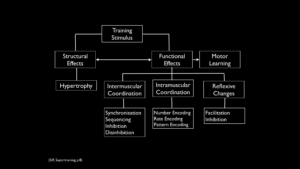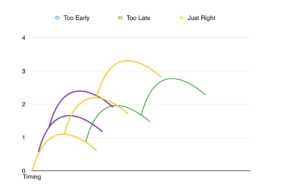Is A Bigger Muscle A Stronger Muscle? Muscle Myths Part III – Intermuscular Coordination
Is A Stronger Muscle Is A Bigger Muscle: Muscle Myths Part II – Inter muscular Coordination
Last time we looked at some of the structural affects of training, namely Functional vs Non Functional Hypertrophy as part of an article written for Ironman Magazine.
This time we turn our attention to the next step of the chart, namely Functional Effects of a Training Stimulus, with this articles focus on Intermuscular Coordination.

Traditionally we always think that if we have a bigger muscle, we have a stronger muscle. But this is only the case “if all other variables are equal”. The truth is, these other variables are really never equal and can be affected a great deal by training.
“The fact that Olympic weightlifters can increase their strength from year to year while remaining at the same body mass reveals that strength depends on other factors as well.” (Siff)
This is also easily seen in the fact that bodybuilders are the most muscular athletes in the world, but they are by no means the strongest, or the most powerful.
The biggest element in the strength training equation, therefore, is from the adaptation of the nervous system.
“Strength is the product of muscular action initiated and orchestrated by electrical processes in the nervous system of the body. Classically, strength is defined as the ability of a given muscle or group of muscles to generate muscular force under specific conditions.” (Siff)
So what role does the nervous system play in strength?
“Strength is not only determined by the amount of muscle mass but also by the extent to which individual fibres in a muscle are voluntarily activated and coordinated between many muscle groups (intermuscular coordination).” (Zatsiorsky)
It’s therefore not only the size of the muscle, but how effectively you can contract it.
Each physical movement is not reliant on one or two muscles contracting, but the coordinated effort of a number of muscle groups that cross a number of joints.
Intermuscular coordination involves the sequencing and synchronisation of different muscle groups to work together optimally to produce any given movement. This may involve the facilitation of:
- Activation
- Timing
- Sequencing of certain muscle groups
- as well as the inhibition of others from cooperating in the execution of a skill.
Intermuscular coordination is coordinating the activity of many muscle groups to achieve the greatest force summation.
Even the simplest exercise is a skilled act requiring the complex coordination of a number of muscle groups.
Take the Posterior Chain for example. Your posterior chain is what is referred to when we are discussing the groups of muscles that make up your back, glutes, hamstrings, etc that contribute to powerful hip extension. These muscles are classically the main ones used in the deadlift, for example.
Inter muscular coordination optimises the activation, timing and sequencing of each of these muscle groups to maximise the total force summation of each movement.
If each group of muscles activate too early the previous muscle hasn’t reached peak contraction yet = suboptimal force summation as noted by the blue lines
If each group of muscles activate too late, the previous muscle has already reached peak contraction and has started to taper off = suboptimal force summation as noted by the green line
If each muscle group times perfectly right at the peak of each previous muscles contraction = optimal force production and a much greater end force produced in the movement as noted by the yellow line

“The movement pattern, rather than the strength of single muscles or the movement of single joints, must therefore be the primary training objective.” (Zatsiorsky)
This has given rise to the term “train movements not muscles” if increasing strength is your objective.
The biggest thing to note here is that
ABSOLUTELY NO CHANGE IN MUSCLE SIZE HAS TAKEN PLACE. ONLY YOUR ABILITY TO ACTIVATE, TIME AND SEQUENCE THE MUSCLES BETTER!!
In a nutshell, neurological adaptation is the highest priority for strength training athletes
Metabolic adaptation is paramount for bodybuilding.
If you want strength, train movements not muscles.
If you want size, train muscles.
Training for performance is NOT the same as training for cosmetic adaptation.
Specificity of your training stimulus is one of the most important factors in your training program success.
And in case you were wondering, you don’t just “max” out your neurological adaptation and then muscular adaptation starts. Again, this is witnessed by elite athletes able to hit new 1RM’s year to year without changes in weight category and increases in “lean mass”
In the next part of the series, we will look at Intramuscular Adaptation as yet another way of increasing neurological adaptation with no change in the muscular size as a way to increase strength.